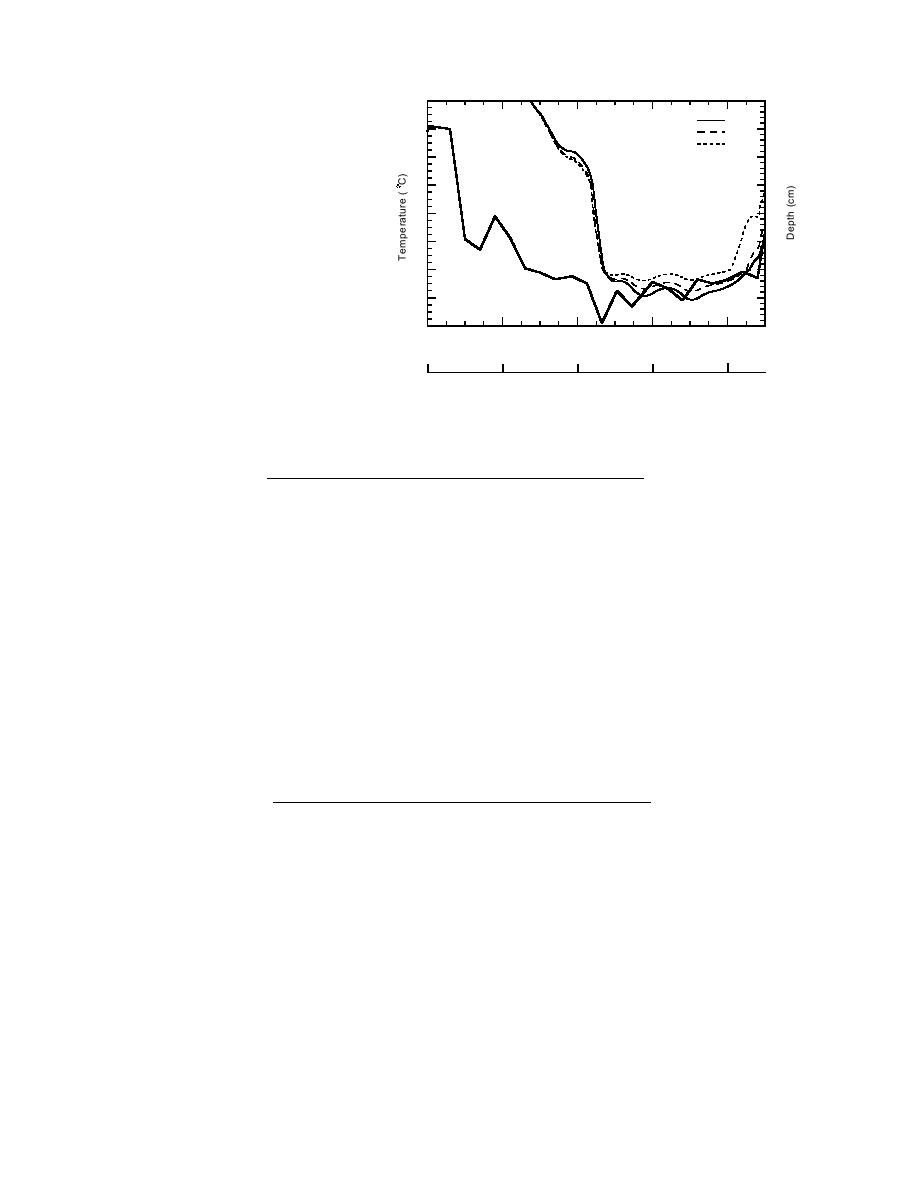
12
0
10%
10
5
17%
25%
8
10
6
15
Figure 14. Location of the freezing front in
4
20
silty soil of 10, 17 or 25% moisture content,
2
25
with a sand inclusion present, as deter-
mined with one-dimensional numerical sim-
0
30
ulations under BC-Warm conditions. The
Surface Temperature
-2
35
imposed temperature history of the soil surface
is also shown.
-4
40
0
40
80
120
160
Day (22 Oct is day 1)
21 Oct
30 Nov
9 Jan
18 Feb
30 March
Table 4. Least soil temperature (C) and earliest day of occurrence
for soil depths of 7.5, 22.5 and 37.5 cm.
Boundary condition
7.5 cm
Day 22.5 cm
Day
37.5 cm Day
BC-Warmest
10% mc no inclusion
0.34
79.2
0.44
87.5
1.09
92.9
sand inclusion
0.34
78.9
0.46
87.7
1.08
102.8
17% mc no inclusion
0.37
77.3
0.35
89.8
0.99
93.2
sand inclusion
0.38
77.5
0.47
90.7
1.15
103.1
25% mc no inclusion
0.38
78.4
0.34
92.0
0.89
105.0
sand inclusion
0.39
78.3
0.53
92.1
1.23
104.8
BC-Warm
10% mc no inclusion
2.48
93.2
0.76
136.3
0.05
142.9
sand inclusion
2.83
93.1
0.88
109.3
0.072
142.3
17% mc no inclusion
2.52
93.1
0.87
136.2
0.06
140.0
sand inclusion
3.10
93.1
1.23
93.5
0.11
143.0
25% mc no inclusion
2.53
93.0
0.90
136.2
0.09
139.1
sand inclusion
3.23
93.1
1.36
93.5
0.18
144.0
BC-Cold
10% mc no inclusion
6.96
112.1
4.01
113.5
1.70
116.9
sand inclusion
7.15
112.2
4.11
113.2
1.59
116.6
17% mc no inclusion
7.03
112.1
4.13
113.0
1.81
116.2
sand inclusion
7.39
112.1
3.95
112.7
1.09
135.5
25% mc no inclusion
7.02
112.1
4.06
113.3
1.73
116.5
sand inclusion
7.56
112.1
3.83
112.4
0.73
135.4
mc: moisture content.
frost and thaw penetration. The maximum
respectively. Without the sand inclusion, an ap-
depth of the freezing front in 17% moisture con-
proximately 17-cm-thick layer of frozen, low
tent soil is slightly greater, on the order of 1 cm,
electrical conductivity soil would underlie a sen-
beneath a sand inclusion compared to that when
sor cable in 17% moisture content soil; the layer
would be ∼1 cm thicker in 25% moisture content
the inclusion is sandy soil (Fig. 15). The sandy
soil thaws more rapidly, which could be detri-
soil. With a sand inclusion present, the sensor
mental in situations of frequent reversals be-
cable would be underlain by a 7.5-cm-thick layer
of low conductivity sand but by only ∼23 cm of
tween warming and cooling trends. The perfor-
mance of a buried electromagnetic sensor sys-
frozen soil. There is a net reduction in the extent
tem would be more stable if any fluctuations in
of the region of low electrical conductivity soil
surface temperature were effectively smoothed
and/or sand beneath the sensor cable when a
at depth by the slow response of the inclusion
sand inclusion is present.
material. Together with the previous observa-
The material of the inclusion does influence
15



 Previous Page
Previous Page
